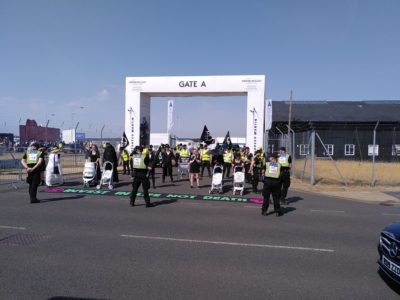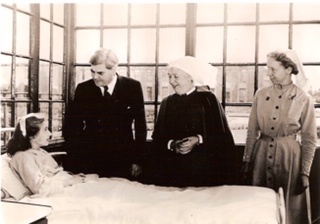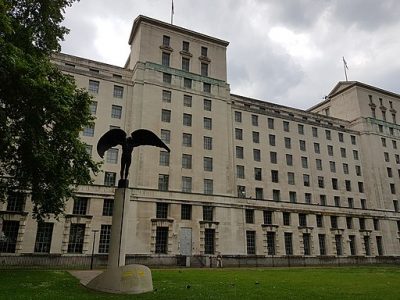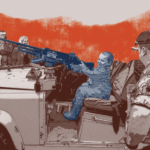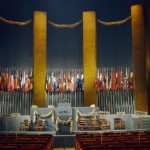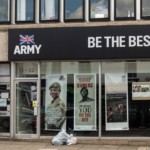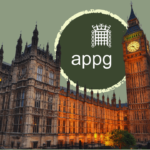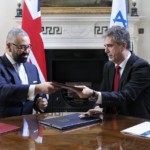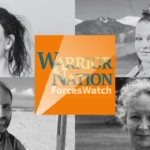Time to give peace education a chance in schools
The Guardian
This Guardian article refers to our report on Peace education and the promotion of the armed forces in UK schools, November 2015.
“Has anyone seen that before?” asks peace educator Jac Bastian as a big CND sign flashes up on the screen at the front of the hall.
“Hippies,” calls a year 12 student from a seat at the back.
“Anywhere else?”
“More hippies,” comes another voice, to laughter.
This is University College school (UCS) in north London, a boys’ independent school that takes girls in the sixth form, and Bastian, who works for the charitably funded education arm of the Campaign for Nuclear Disarmament, is here to talk to year 12 about Hiroshima and Trident.
There is some muttering, and a few jokes about North Korea and Iran as well as hippies, but the students can name all the places where nuclear weapons have been tested, and someone even knows the most up-to-date figure for the number of nuclear warheads in the UK (215). A clip from Keiji Nakazawa’s animation Barefoot Gen, in which he remembers his childhood experience of the Hiroshima bomb, is received in respectful silence.
At the end Bastian announces a blind vote – where students raise their hands while covering their eyes – as to whether Trident should be replaced, and the room divides roughly evenly.
It’s not just a drift. The MoD’s youth strategy has building support for the armed forces as an objective
CND’s visit, arranged by geography teacher Emma Taylor, is part of an enrichment programme of talks from external speakers, but voluntary sector organisations, along with the United Nations, believe peace education should be more than an extra in British schools, or a one-off assembly like this one. This week ForcesWatch, a pressure group mostly concerned with the UK armed forces’ recruitment of children, publishes a report that draws attention to recommendations by the UN Committee on the Rights of the Child in 2008, and what it sees as the UK’s inadequate response.
“The committee was concerned about the lack of any structured programme of peace and human rights education and recommended such a programme should become part of the curriculum,” says ForcesWatch coordinator and the report’s author, Emma Sangster.
“There are definitely two issues – one is interpersonal relationships between young people and the other is developing awareness of alternatives to conflict politically and socially. I think peace education covers both.”
Last year the UK reported back to the UN on its implementation of the Convention on the Rights of the Child, including references to democracy and rights in its submission, but not peace. Sangster says ForcesWatch’s “particular concern is that not only have the recommendations not been implemented, but the balance has become more in favour of the military rather than less. The key development since 2008 in English and Welsh schools is the ‘military ethos’ programme, which covers the expansion of the Combined Cadet Force, alternative provision with a military ethos and the Troops to Teachers scheme”.
Peace education, as Sangster says, has two distinct strands, as well as roots in religion, pacifism and campaigning. Catholic peace organisation Pax Christi and Quakers in Britain are the two most prominent religious sponsors of peace lessons, while another group, Spiritual England, is behind the recently launched Peaceful Schools Movement.
One kind of peace education focuses on learning about peace and war in the context of history or current affairs, the assembly at UCS being an example. In another of CND’s lessons, primary-age children are taught to make the origami birds known as “peace cranes” that have become a symbol of remembrance of Hiroshima. Another lesson sees the teacher cast as an MP deciding whether to support a pressure group. ForcesWatch and Veterans for Peace also do a small number of school visits.
The other aspect of peace education is more skills-focused, with organisations such as Peacemakers in Birmingham and Cresst in south Yorkshire offering activities focused on conflict resolution and peer mediation.
Bastian says the debate about Trident, along with Jeremy Corbyn’s election as leader of the Labour party, has made nuclear weapons more topical than they have been for years, and teachers at UCS were keen to emphasise the salience of a debate on nuclear weapons in the week Scottish Labour voted to oppose Trident’s replacement.
Armistice Day and Remembrance Sunday provide another focus for debate, and their importance has been heightened by the 2014 first world war centenary. Last year a project called Wales for Peace won £900,000 lottery funding for a scheme looking at Welsh initiatives for peace, and in May St Richard Gwyn Catholic high school in Barry, Glamorgan, opened its own peace garden. At Notre Dame RC Girls’ school in south London, the justice and peace group, run by the head of religious education, has been wearing, white poppies over the past week.
The head of peace education at Quakers in Britain, Isabel Cartwright, says schools can find it hard to teach remembrance without glorifying war. “You don’t have to be against the military to be concerned about the growing role of the armed forces in education, and peace projects have sprung up in response,” she says. “It’s not just a drift. The Ministry of Defence’s youth engagement strategy has building support for the armed forces as an objective.”
Sangster says £95m of new funding has been provided for the military ethos in schools project since 2012, including £50m for expanding cadet forces. She contrasts the government’s stated position in its 2014 submission to the UN – that it is up to individual schools to “raise issues with pupils according to their age, needs and interests” – with the high-level support and free resources attached to military initiatives, such as the British Armed Forces Learning Resource produced by the Ministry of Defence and the prime minister’s office last year.
“It becomes difficult for schools and young people to look at conflict in a critical way when the overriding messages are about recognition and respect for the armed forces,” she says.
A handful of schools have, however, adopted policies of not letting the military in, while one family, which did not want to be identified, complained to their daughter’s primary headteacher after she handled a replica weapon at a military activity day. Another set of parents were unhappy when their teenage daughter was refused permission to sell white poppies at school.
The DfE, asked whether the government believes in peace education, as recommended by the UN, in English and Welsh schools, said: “We have given teachers the freedom to create lessons that will stimulate debate and discussions about issues like peace and the consequences of war and we know the best schools are doing this. Through citizenship children should also be taught about the importance of mutual respect and understanding.”
Quaker educator Ellis Brooks says: “There are opportunities for peace education if you know where to look for them”, including in the enhanced status granted to spiritual, moral, social and cultural development. But the “empathy development” Quakers and others believe is crucial to peace education is missing from official guidance. The result, Brooks says, is that “we hear lots about British military ethos and values and very little about peace”.
See more: military in schools/colleges, remembrance, ForcesWatch, peace education

